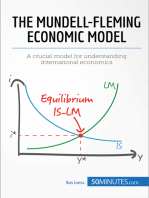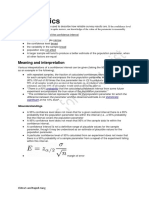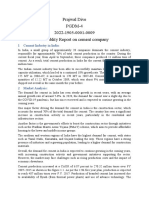Macro 5
Macro 5
Uploaded by
Rajesh GargCopyright:
Available Formats
Macro 5
Macro 5
Uploaded by
Rajesh GargOriginal Description:
Original Title
Copyright
Available Formats
Share this document
Did you find this document useful?
Is this content inappropriate?
Copyright:
Available Formats
Macro 5
Macro 5
Uploaded by
Rajesh GargCopyright:
Available Formats
____________________________________________________________________________________________________
1. Learning Outcomes
After studying this module you shall be able to
(i) Know about the Classical quantity theory of money
(ii) Understand the Neutrality of Money
(iii) Know about the Classical Money Market Equilibrium
2. Introduction
Classical approach to macroeconomics is based on the assumption that individuals and
firms act in their own best interest and wages and prices adjust quickly to achieve
equilibrium in all markets. Classical Economist stress the role of real factors in determining
real variables such as output, employment and interest rate. Classical economists stress the
self-adjusting tendency of economy. According to them government policies to ensure
adequate demand and output is unnecessary. Under these assumptions the invisible hand
of the free market works well in various markets including goods market, money market
and labour market without any government intervention. In particular wages and prices
adjust rapidly to maintain equilibrium in various markets. In the classical money market
the demand for money comes from the households and the money is supplied by the
government agency that is the Central bank. The Classical theory proposes that all the
markets re-equilibrate because of adjustment in prices and wages which are flexible. Also,
since according to the Classicals Supply creates its own Demand so business cycles are
natural processes of adjus
part, economy works out its problems on its own. The classical economists did not
explicitly formulate demand for money theory but their views are inherent in the quantity
ECONOMICS Paper 4: Basic Macroeconomics
Module 8: Classical Theory - Money Market
____________________________________________________________________________________________________
theory of money. They emphasized the transactions demand for money in terms of the
velocity of circulation of money or through the Quantity theory of money
3.
A central relationship in the classical model of Money Market is the Classical Quantity
Theory of Money (QTM). The classical quantity theory of money has two formulations
under it:
Velocity Formulation
Cash balance formulation
VELOCITY FORMULATION:
Classical QTM explains relationship between Quantity of Money and general price level.
According to it there is a direct and equi propotionate relationship between quantity of
money and general price level. The basic equation of QTM is expressed by equation of
exchange which is expressed as
MVt = PtT
where M is the Quantity of Money, V is the velocity of money which may be defined as
the rate at which money turns over in GDP transactions during a given period. P is the price
index of items traded and T is the volume of transactions. Another expression of the
equation of exchange focuses on income transaction i.e. MV = PY where V is the income
velocity of money. MV represents the supply of money which is given and in equilibrium
equals the demand for money. Thus, the equation now becomes: Md = PY. This
transactions demand for money, in turn, is determined by the level of full employment
income.
According to classical QTM, output is constant at full employment level because labour
market is always in equilibrium, so V also remains constant. So if V is fixed and output i.e.
Y is constant then there exists a direct and equi-propotionate relation between M and P.
t proportion of the level of
ECONOMICS Paper 4: Basic Macroeconomics
Module 8: Classical Theory - Money Market
____________________________________________________________________________________________________
transactions, which in turn, bears a constant relationship to the level of national income.
Further, the demand for money is linked to the volume of trade going on in an economy at
any time. Thus the underlying assumption here is that people hold money to buy goods.
CASH BALANCE FORMULATION:
It is another version of the QTM that focuses on the demand for money and says that
demand for money is a fraction of nominal income i.e.
Md = k(PY)
suring the amount of nominal GDP kept in cash
form.
This approach partly overcomes the limitation of the first approach under which demand
for money was not clear and the focus was how rapidly money is spent and that is why
called the velocity formulation approach. So, in equilibrium the exogenous supply of
money must equal quantity of money demanded i.e. M/k = PY or MV = PY , where V =
1/k.
4. Neutrality of Money (Monetary Neutrality)
According to the classical QTM, quantity of money is the only factor that determines price
level whereas other factors such as labour supply, demand and production function play no
role because these three are real variables. So neutrality of Money says that the Demand
for money is determined only by nominal variables and real variables have no role in it.
On the other hand Fisher effect refers to the one for one relationship between inflation rate
and nominal interest rate. The Fisher effect is also based on classical dichotomy, which in
turn depend on neutrality of money. According to classical dichotomy there is a theoretical
separation of real and nominal variables and monetary neutrality means that money is
irrelevant for real variables therefore, when quantity of money increases then there is
increase in the price level in the same proportion. As a result of high inflation, nominal
ECONOMICS Paper 4: Basic Macroeconomics
Module 8: Classical Theory - Money Market
____________________________________________________________________________________________________
interest rate increases in the same proportion because of Fisher effect and the real interest
rate remains unchanged.
MONEY MARKET:
The money supply curve in the classical Money Market is determined from the LM curve
which is the liquid money market. The equation of the LM curve is kY hi = M/P where
k is sensitivity of investment to interest rate, Y is the output, h is the is sensitivity of money
demand to change in interest rate, i is the rate of interest and M/P is the real money supply.
will be zero i.e. demand for money is entirely irresponsive to changes in real interest rate.
S, the LM equation can now be reduced to the equation of QTM i.e. kY =M/P or M = k(PY)
case. The vertical money supply curve shows the exogenously given money supply by the
Central Bank i.e. MS = M
FIGURE 3.1: Money Supply and Money Demand
The demand for money in the classical case is determined from the classical QTM which
says money demand varies directly with price level MD =k(PY). With larger incomes,
people want to make larger volumes of transactions and that larger cash balances will,
therefore, be demanded. Md is the demand for money which must equal the supply to
ECONOMICS Paper 4: Basic Macroeconomics
Module 8: Classical Theory - Money Market
____________________________________________________________________________________________________
money (Md=Ms) in equilibrium in the economy, k is the fraction of the real money income
(PY) which people wish to hold in cash and demand deposits or the ratio of money stock
to income, P is the price level, and Y is the aggregate real income. This equation tells us
t
proportional to the nominal level of income for each individual, and hence for the aggregate
The supply of money is fixed and it is supplied by the Central bank.
5. Money Market Equilibrium
The money market equilibrium requires that MS = MD . That is MS = kPY. It is also
remembered here that Y is fixed due to the existence of full employment in the economy.
Fig 3.2 represents money market equilibrium where the diagram has total money stock M
on the horizontal axis and the levels of PY on the vertical axis. The line (OL), the slope
of which is (1/k), shows the levels of PY that can be supported by different quantities of
ECONOMICS Paper 4: Basic Macroeconomics
Module 8: Classical Theory - Money Market
____________________________________________________________________________________________________
money supply. As the money supply increases from M1 to M2, the price level rises
proportionately from P1 to P2. Thus, this relationship between money supply and the
price level: an excess money supply which generally means increased demand for
commodities that pulls up the general price level also. Also by Monetary Neutrality
money supply has no impact on Y which is determined in the real sector and Y is fixed
due to full employment. The only way that the classical money market equilibrium can
change is only due to any shift in the labour supply and labour demand curve.
ECONOMICS Paper 4: Basic Macroeconomics
Module 8: Classical Theory - Money Market
You might also like
- Commerce Green BookDocument95 pagesCommerce Green Bookchenu sumani50% (2)
- A Product Project Report On Mushroom ChipsDocument74 pagesA Product Project Report On Mushroom ChipsDharmesh Savita100% (1)
- SOP For Transfer Order RequestDocument2 pagesSOP For Transfer Order RequestERP Finance SupportNo ratings yet
- Theories of Demand For MoneyDocument18 pagesTheories of Demand For MoneyAppan Kandala Vasudevachary80% (15)
- Demand For MoneyDocument16 pagesDemand For MoneyAppan Kandala Vasudevachary100% (2)
- 1456981054ECO P4 M8 E-TextDocument9 pages1456981054ECO P4 M8 E-TextPuja KumariNo ratings yet
- Learning OutcomesDocument9 pagesLearning OutcomesRajesh GargNo ratings yet
- Unit 4 - Class 3 PPT - Classical & Keynesian ApproachDocument24 pagesUnit 4 - Class 3 PPT - Classical & Keynesian Approachshivam kumarNo ratings yet
- Mba 022Document10 pagesMba 022Hezekia KiruiNo ratings yet
- Essay On Monetary Policy and Economic Growth - OkDocument25 pagesEssay On Monetary Policy and Economic Growth - OkIvan LovreNo ratings yet
- Worksheet For Chapter 5 (2023)Document25 pagesWorksheet For Chapter 5 (2023)Ncebakazi DawedeNo ratings yet
- DavidDocument8 pagesDavidHezekia KiruiNo ratings yet
- Bible Revision NotesDocument7 pagesBible Revision NoteshezronNo ratings yet
- Classical Theory of Income & Employment (Lecture - 6)Document18 pagesClassical Theory of Income & Employment (Lecture - 6)Salman HaiderNo ratings yet
- Value of Money A Comparative StudyDocument14 pagesValue of Money A Comparative StudyMainul HossainNo ratings yet
- The Quantity Theory of MoneyDocument8 pagesThe Quantity Theory of MoneyHean PengcheangNo ratings yet
- Quantity Theory of MoneyDocument6 pagesQuantity Theory of MoneyBernard OkpeNo ratings yet
- How Is The General Price Level Determined? Why Does Price Level Change? Classical or Pre-Keynesian Economists Answered AllDocument8 pagesHow Is The General Price Level Determined? Why Does Price Level Change? Classical or Pre-Keynesian Economists Answered AllpriyankabgNo ratings yet
- Demand and Supply For MoneyDocument10 pagesDemand and Supply For MoneynderitoaustinNo ratings yet
- Ch. 4 Demand For MoneyDocument13 pagesCh. 4 Demand For Moneycoldpassion100% (1)
- Explain The Quantity Theory of MoneyDocument6 pagesExplain The Quantity Theory of MoneyIshika YadavNo ratings yet
- 3, Monetar 2Document9 pages3, Monetar 2tesfayegedefa02No ratings yet
- Money Demand (1) - 1Document9 pagesMoney Demand (1) - 1kritikachhapoliaNo ratings yet
- 2d166the Quantity Theory of MoneyDocument3 pages2d166the Quantity Theory of MoneyShubhamNo ratings yet
- CH 4Document3 pagesCH 4Umer IqbalNo ratings yet
- Intermediate Macroeconomics (Ecn 2215) : Money and Inflation Lecture Notes by Charles M. Banda Notes Extracted From MankiwDocument25 pagesIntermediate Macroeconomics (Ecn 2215) : Money and Inflation Lecture Notes by Charles M. Banda Notes Extracted From MankiwYande ZuluNo ratings yet
- Quantity Theory of MoneyDocument3 pagesQuantity Theory of MoneyVictoriano GalaNo ratings yet
- Quantity Theory of MoneyDocument3 pagesQuantity Theory of MoneySyed Zuhayr ZamanNo ratings yet
- Ch20 - Quantity Theory of MoneyDocument18 pagesCh20 - Quantity Theory of MoneyLê Đặng Minh ThảoNo ratings yet
- Unit 2 - The Demand For MoneyDocument31 pagesUnit 2 - The Demand For Moneyrichard kapimpaNo ratings yet
- Classical Model 1Document6 pagesClassical Model 1blipbruceNo ratings yet
- Money Supply GrowthDocument27 pagesMoney Supply GrowthShapolaNo ratings yet
- Topic 03C InflationDocument31 pagesTopic 03C InflationhoshinghangNo ratings yet
- Group 4 - Inflation - Its Causes, Effects, and Social CostsDocument48 pagesGroup 4 - Inflation - Its Causes, Effects, and Social Costsmyaccount foreverythingNo ratings yet
- Lecture 6 IMEDocument21 pagesLecture 6 IMEGaurav MadaanNo ratings yet
- Chapter 11Document178 pagesChapter 11andrew myintmyatNo ratings yet
- Rabin A Monetary Theory 21 25Document5 pagesRabin A Monetary Theory 21 25Anonymous T2LhplUNo ratings yet
- Lecture 03 Notes - Spring 2009 PDFDocument8 pagesLecture 03 Notes - Spring 2009 PDF6doitNo ratings yet
- Monetary PolicyDocument5 pagesMonetary PolicysarahanifNo ratings yet
- Unit5 MoneyDocument34 pagesUnit5 Moneytempacc9322No ratings yet
- MoneyDocument7 pagesMoneyshortsmotivationhubNo ratings yet
- The Relevance of Monetary FlowsDocument21 pagesThe Relevance of Monetary FlowsMike HoffmanNo ratings yet
- Macro I Chapter Three 2-1-1Document44 pagesMacro I Chapter Three 2-1-1History and EventNo ratings yet
- PS7 2012 SolutionsDocument7 pagesPS7 2012 SolutionsMatthew ZukowskiNo ratings yet
- Mishkin - 09 - c19 Money DemandDocument34 pagesMishkin - 09 - c19 Money DemandIn DangerNo ratings yet
- Module 1 IntroductionDocument55 pagesModule 1 Introductionfosejo7119No ratings yet
- Macro 13Document19 pagesMacro 13Rajesh GargNo ratings yet
- Monetary Theory of InflationDocument17 pagesMonetary Theory of InflationRicky EnsanoNo ratings yet
- Chapter 2: Review of LiteratureDocument49 pagesChapter 2: Review of LiteratureRehan UllahNo ratings yet
- Lecture FourDocument10 pagesLecture Fourderrick.hashimNo ratings yet
- Learning OutcomesDocument10 pagesLearning OutcomesRajesh GargNo ratings yet
- Inflation A Supply Side AnalysisDocument12 pagesInflation A Supply Side AnalysisSAURAV KALITANo ratings yet
- Quantity Theory of MoneyDocument4 pagesQuantity Theory of MoneyNazmun BegamNo ratings yet
- Quantity Theory of MoneyDocument11 pagesQuantity Theory of Moneysamairamalik.2006No ratings yet
- Theory of Money DemandDocument3 pagesTheory of Money DemandshikhameNo ratings yet
- Demand of Money: A Presentation by Sahil MirDocument14 pagesDemand of Money: A Presentation by Sahil MirSahil MirNo ratings yet
- DFCH 16Document28 pagesDFCH 16chisomosimbi69No ratings yet
- Chapter 17 Summary Principles of MacroeconomicsDocument9 pagesChapter 17 Summary Principles of MacroeconomicsOLFA ALOUININo ratings yet
- The Mundell-Fleming Economic Model: A crucial model for understanding international economicsFrom EverandThe Mundell-Fleming Economic Model: A crucial model for understanding international economicsNo ratings yet
- NBER Macroeconomics Annual 2013: Volume 28From EverandNBER Macroeconomics Annual 2013: Volume 28Jonathan A. ParkerNo ratings yet
- Inflation-Conscious Investments: Avoid the most common investment pitfallsFrom EverandInflation-Conscious Investments: Avoid the most common investment pitfallsNo ratings yet
- Macro 14Document18 pagesMacro 14Rajesh GargNo ratings yet
- Industrial Eco 2Document16 pagesIndustrial Eco 2Rajesh GargNo ratings yet
- Macro 15 PDFDocument5 pagesMacro 15 PDFRajesh GargNo ratings yet
- Industrial Eco 1Document12 pagesIndustrial Eco 1Rajesh GargNo ratings yet
- Industrial Eco 4Document12 pagesIndustrial Eco 4Rajesh GargNo ratings yet
- Learning OutcomesDocument7 pagesLearning OutcomesRajesh GargNo ratings yet
- Macro 13Document19 pagesMacro 13Rajesh GargNo ratings yet
- Learning OutcomesDocument14 pagesLearning OutcomesRajesh GargNo ratings yet
- Macro 2Document9 pagesMacro 2Rajesh GargNo ratings yet
- Macro 9Document9 pagesMacro 9Rajesh GargNo ratings yet
- Macro 3Document9 pagesMacro 3Rajesh GargNo ratings yet
- Learning OutcomesDocument10 pagesLearning OutcomesRajesh GargNo ratings yet
- Learning OutcomesDocument6 pagesLearning OutcomesRajesh GargNo ratings yet
- Macro 4Document15 pagesMacro 4Rajesh GargNo ratings yet
- Learning OutcomesDocument9 pagesLearning OutcomesRajesh GargNo ratings yet
- Learning OutcomesDocument8 pagesLearning OutcomesRajesh GargNo ratings yet
- Agriculture Ies Unit 5Document71 pagesAgriculture Ies Unit 5Rajesh GargNo ratings yet
- Theory of EmploymentDocument19 pagesTheory of EmploymentRajesh GargNo ratings yet
- Learning Outcomes: Why Study National Income Accounts?Document8 pagesLearning Outcomes: Why Study National Income Accounts?Rajesh GargNo ratings yet
- Budgeting and Fiscal PolicyDocument23 pagesBudgeting and Fiscal PolicyRajesh GargNo ratings yet
- Fin Eco 7Document14 pagesFin Eco 7Rajesh GargNo ratings yet
- Fineco 1 PDFDocument30 pagesFineco 1 PDFRajesh GargNo ratings yet
- Stats ENTRACE PREPDocument111 pagesStats ENTRACE PREPRajesh GargNo ratings yet
- Fin Eco 9 PDFDocument8 pagesFin Eco 9 PDFRajesh GargNo ratings yet
- HypothesisDocument1 pageHypothesisRajesh GargNo ratings yet
- Learning Outcomes: 2.1 OptionsDocument10 pagesLearning Outcomes: 2.1 OptionsRajesh GargNo ratings yet
- Fin Eco 4Document17 pagesFin Eco 4Rajesh GargNo ratings yet
- Fin Eco 6Document7 pagesFin Eco 6Rajesh GargNo ratings yet
- Fin Eco 5Document6 pagesFin Eco 5Rajesh GargNo ratings yet
- Chapter 10 - International Business FinanceDocument5 pagesChapter 10 - International Business FinanceNicole Feliz InfanteNo ratings yet
- Properties in PakistanDocument205 pagesProperties in PakistanAdnan Adil HussainNo ratings yet
- Ch 8. Process Costing Booster MasterclassDocument12 pagesCh 8. Process Costing Booster Masterclassbhumika chauhanNo ratings yet
- Audit of Revenue Receipt CycleDocument23 pagesAudit of Revenue Receipt CycleDebbie Grace Latiban LinazaNo ratings yet
- Chapter 14 QuestionsDocument16 pagesChapter 14 Questionstuanminh2048No ratings yet
- Bitcoin - The History of MoneyDocument3 pagesBitcoin - The History of MoneyIrina SoareNo ratings yet
- AIG Credit Card AuthorizationDocument2 pagesAIG Credit Card Authorization305allstarsNo ratings yet
- Merchant Mth-October 2022Document1 pageMerchant Mth-October 2022SUNIRUL SKNo ratings yet
- Afar Franchise AccountingDocument1 pageAfar Franchise AccountingMarielle Guerra04No ratings yet
- Unionbank Sec CertDocument3 pagesUnionbank Sec CertJovy JorgioNo ratings yet
- Chap 7Document36 pagesChap 7ezperanzadlmtNo ratings yet
- 7 Ways To Fail BigDocument3 pages7 Ways To Fail BigSajid Khattak100% (1)
- Cement Industry Feasibility ReportDocument4 pagesCement Industry Feasibility Reportds ww100% (1)
- Quiz 3 CMA Sec - ABCDocument2 pagesQuiz 3 CMA Sec - ABCNijeshkumar PcNo ratings yet
- PHR 20240321 BuyDocument14 pagesPHR 20240321 BuyphatNo ratings yet
- ONGCAr 2014Document168 pagesONGCAr 2014kamaldharevaNo ratings yet
- Summary 300 LogementDocument8 pagesSummary 300 Logementmariekone79No ratings yet
- Corporate HistoryDocument5 pagesCorporate HistoryishaNo ratings yet
- New Microsoft Word DocumentDocument4 pagesNew Microsoft Word DocumentJitendra SolankiNo ratings yet
- EUFEMIA EVANGELISTA VDocument3 pagesEUFEMIA EVANGELISTA VLina RheaNo ratings yet
- ABC Inventory Control AnalysisDocument16 pagesABC Inventory Control Analysisanuragbhardwaj07No ratings yet
- Operation Risk Management PDFDocument13 pagesOperation Risk Management PDFANKUR PUROHITNo ratings yet
- Macroeconomics For Today 9th Edition Tucker Test Bank 1Document73 pagesMacroeconomics For Today 9th Edition Tucker Test Bank 1rosemary100% (64)
- Sample Exam 2Document7 pagesSample Exam 2Kateryna TernovaNo ratings yet
- Blended Rangoli PMS - Mar'24Document10 pagesBlended Rangoli PMS - Mar'24murarikrishan720No ratings yet
- Securities MarketDocument32 pagesSecurities MarketNur Aisyah FitriahNo ratings yet
- Multi BillDocument4 pagesMulti BillghareebNo ratings yet




















































































































